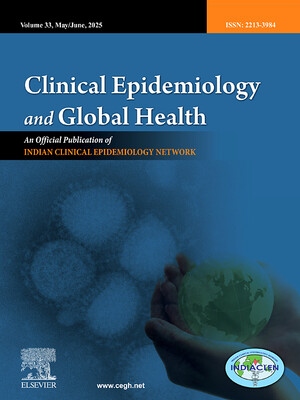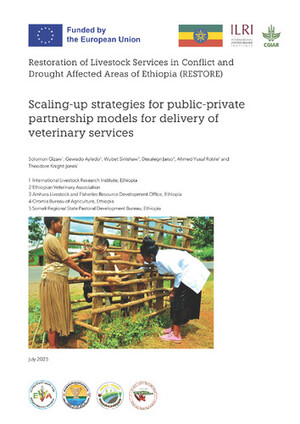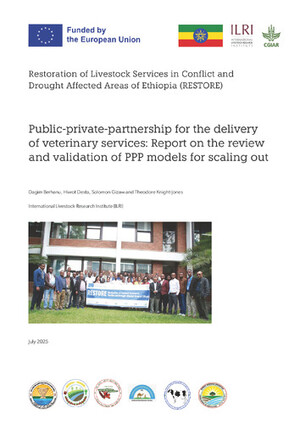
Tick control: How cattle owners are reducing acaricide efficacy and increasing tick resistance
Introduction
Ticks are nuisance external parasites on wildlife, livestock, dogs and sometimes human hosts. Ticks suck blood from their hosts and damage their skins reducing productivity and causing discomfort to the host. Additionally, ticks are vectors that transmit disease-causing pathogens to their hosts. Of agricultural importance are ticks impact on livestock; they transmit diseases such as anaplasmosis and babesiosis East Coast fever and heartwater. These effects lead to reduced animal weight and milk productivity, in turn hurting livestock owners' income and livelihoods. Livestock owners reduce the effects of ticks mainly through tick control using chemicals known as acaricides. Acaricides come from different groups identified by their active ingredients, with different modes of action to kill the ticks. Amitraz, synthetic pyrethroids, organophosphates or combinations of these active ingredients are some of the commonly available acaricide in the market.
Background to tick control in Kenya
In Kenya, the Department of Veterinary Services (DVS), under the Ministry of Livestock, was responsible for the control of ticks across the country from the colonial government until the enactment of the structural adjustment policies (SAPs) in 1991, that privatised animal health. The Tick Control Program under the DVS ensured that cattle dips were provided with acaricides and well replenished under the supervision of dip attendants. After 1991, government funding to animal health was withdrawn and tick control suffered massively. Half of the dips in the country collapsed by the end of 1992, which was followed by a rapid upsurge of tick-borne diseases, predominantly East Coast fever. During this period people shifted from communal cattle dips and started spraying their livestock at home. This era marked the liberalization of the animal health market, mushrooming of agrovet shops (shops where acaricides and livestock drugs are sold) across the country, and the exit of the DVS in active tick control.
The problem
The exit of the DVS from active tick control at the farm level left livestock owners to rely on self-taught, trial-and-error tick control methods while discovering the use of acaricides without guidance and monitoring from veterinary officers. This led to a mix of acaricide use practices that over the years have been reported to be risky for livestock, humans and the environment, and sometimes to reduce their efficacy—the number of ticks killed from an acaricide treatment. Successful tick control by acaricides relies on the livestock owner’s knowledge about ticks, acaricides and how appropriately these acaricides are applied. It also relies on the correct mixing ratio of acaricides and water to get the recommended concentration of active ingredients to effectively kill ticks. This information is often found on the information label that comes with acaricides products from different manufacturers.
A study by researchers from the Wageningen University, International Livestock Research Institute (ILRI), Radboud University, the Institute of Virology and Immunology and the University of Bern explored where livestock owners accessed acaricides from and how their use and application practices contributed to reported tick treatment failures. The study also sought to find out what acaricides were available for purchase by livestock owners and their knowledge on the use of these acaricides. This study was carried out in two livestock systems: two commercial ranches and two pastoral communities in Kenya's Laikipia County by observing practices, interviewing livestock owners and chemical analyses of acaricides from agrovet shops and acaricide mixes from farms.
What did the study find?
The study found out that all livestock owners had access to and used chemical acaricides for tick control from agrovet shops, either permanent or mobile ones that ‘move’ to the respective market centres in the region on designated market days. These permanent agrovet shops are owned by qualified and licenced livestock health practitioners, but only a few of the employed qualified and certified animal health professionals as shop attendants. The majority employed school leavers who did not have the relevant technical knowledge required to advise cattle owners. This was cited as one of the reasons why cattle owners neither trust nor seek the advice of agrovet shop attendants as 'they are just children who have left school and are not knowledgeable on tick control.' Commercial ranchers were advised by researchers visiting their ranches.
The study found that predominantly amitraz-based acaricides were used, and fewer livestock owners preferred synthetic pyrethroids, organophosphates, or combination-based acaricides as in the summary table below. The majority of pastoral cattle owners seek acaricide information from their friends and family members, with a small number consulting with agrovet shop attendants. They rely on their own experience with different acaricide brands and referrals from peers.

The commonly stocked and used acaricides within the study area. Four classes of acaricides were identified with the most common acaricide brand names they are sold by. Insecticides and crop pesticides were also identified as other chemicals that livestock owners use to kill ticks. The use of these insecticides and pesticides for tick control is strongly discouraged because they are absorbed differently in the body and could lead to risky healthy effects to the livestock, humans that consume affected livestock products and the environment.
In the pastoral livestock system, livestock owners mainly bought acaricides during market days. The choice of acaricide was informed by what they perceived to be 'strong' (effective) acaricides, cost of acaricide, money available on the day of purchase, and the availability of the desired acaricide in order of priority. It was observed that livestock owners would buy acaricides from all four acaricide groups within a short period of time ranging between weeks and two to three months. It is recommended that one uses an acaricide from one class for at least six months and only switch to a different acaricide if they do not see the desired results. Consistent use of one acaricide discourages the development of resistance in ticks through selective pressure.
All acaricides sampled from agrovet shops were found to contain the concentration of active ingredients at par with the content description on the labels. This implies that the quality of acaricides in the market meets the standards to effectively kill ticks if correctly used and appropriately applied. Correct and appropriate use refers to the ratio of acaricide that is mixed with water and how this mixture is applied on the livestock, either by spraying or dipping.
Chemical analysis of acaricide dilutions collected from livestock owners showed quantities of active ingredients were largely higher or below the level recommended for effective treatment. This can be explained by observed dilution behaviours by livestock owners where they did not keenly follow 'use instructions' given on the product labels. Higher or lower active ingredient concentrations than recommended were as a result of adding more acaricide than recommended or using the bottle cup instead of measuring cylinder provided or 'by use of the eyes' to measure acaricide added to water. Lower acaricide concentrations mean that the mixture is not strong enough to kill ticks and hence treatment fails. High acaricide concentrations implied that many ticks are killed but due to selective pressure, few individuals survive and build up resistance against the acaricide.
It was observed that cattle owners also used insecticides and crop pesticides for tick control. They used them in isolation or mixed them with acaricides that were perceived to be weak. Livestock owners argued that adding pesticides and /or insecticides to acaricides increased their ‘strength’ (potency) to kill ticks, which they had observed from trial and error over time. This has not been proved scientifically. Active ingredients in acaricides, pesticides and insecticides have different modes of action with different target sites on parasites. Thus, mixing them would lead to chemical antagonisms that would in effect reduce the efficacy of the different active ingredients. This behaviour should be greatly discouraged amongst livestock owners.
Commercial ranchers source acaricides directly from production companies and buy in bulk, thus they are consistent with the use of one acaricide over a long time and only use a different acaricide from a different class to break a cycle once they observe increased tick loads with reduced treatment success. Ranches spray cattle using spray races due to the large numbers of cattle to be sprayed up to 1,000 in single spray exercise in groups of 100 individuals. The study found that the concentration of the spray dilution at the start of the spraying exercise was high at the recommended level and declined towards the middle, and was almost depleted at the end, of the exercise. This means that cattle sprayed at the start received maximum protection while those sprayed the last received minimal to no protection. Reconsidering spray dilutions in relation to the number of cattle sprayed, or reducing the number of cattle sprayed at any one time can help address this problem.
Summary
The study results show that the efficacy (ticks killed and concentration of active ingredients) is indeed compromised. The active ingredients in acaricides as supplied is from agrovet shops is satisfactory, but in acaricide dilutions collected from farms is too low or too high. This shows that acaricides use practices by cattle owners are the ones responsible for the loss of efficacy to kill ticks.
These findings on acaricide access and use practices by livestock keepers in Kenya show the development of tick control at farms in the absence of advisory from the DVS. It points to serious gaps in knowledge amongst livestock owners in the appropriate use of acaricides and how these practices set the stage for tick treatment failure, livestock and human health risks, and potential acaricide resistance by ticks. The critical role of knowledge sharing between animal health experts and livestock owners is clear as is the need for technical information to inform practice. Thus, it is necessary to provide platforms for knowledge sharing between livestock owners and animal health experts to correct and improve acaricide use practices.
Read more from the study: https://hdl.handle.net/10568/114057



















